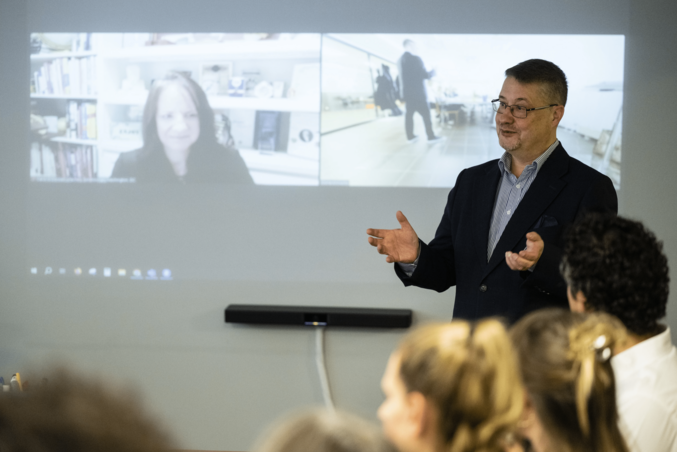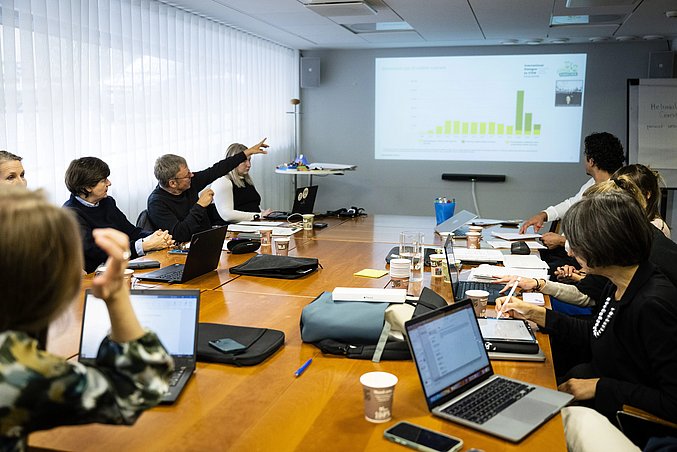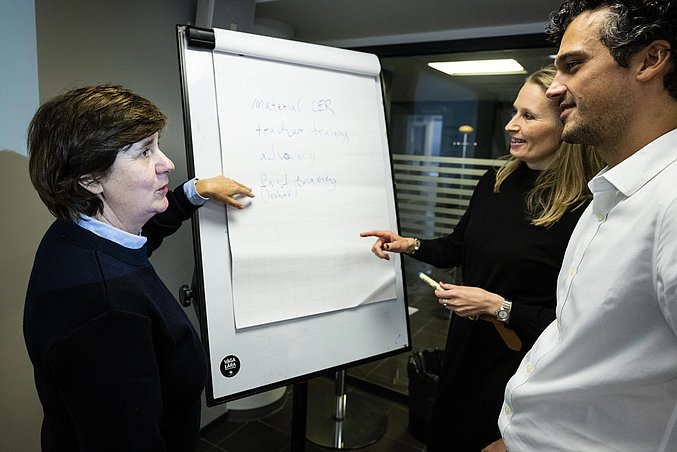
© Veikko Somerpuro / Stiftung Kinder forschen / The IDoS peers met in Finland, Helsinki this year to discuss early STEM Education
IDoS Peer Meeting in Finland: STEM Education faces Challenges Worldwide
On 9 and 10 October 2023, representatives from the six member organisations (peers) of the International Dialogue on STEM Education (IDoS) met in person again for a peer meeting in Helsinki, Finland. The peers discussed the state of early STEM Education in their respective countries and focus regions. They also planned and outlined their next publication on the focus topic of “STEM Education in the Digital Age”.

© Veikko Somerpuro / Stiftung Kinder forschen / Prof. Jan Lundell of LUMA welcoming the peers at the University of Helsinki
This year’s in-person meeting was hosted by IDoS peer LUMA Centre Finland, at the University of Helsinki. Other peers present were: Stiftung Kinder forschen, Siemens Stiftung, Office for Climate Education (OCE), Fondation La main à la pâte (LAMAP), and Smithsonian Science Education Center (SSEC) (virtually).
The University of Helsinki with its TikTok-famous LUMA-lab, the ChemistryLab Gadolin, is one of 13 centres that support the training of STEM teachers and that help coordinate LUMA’s STEM Education programme all over Finland. At the LUMA-labs, pre-service teachers learn hands-on STEM Education and work as instructors for study visits, clubs, and science parties. Similarly, teacher training programmes have been carried out here since 2008.
Insights from Day 1:
STEM Education faces a relevance problem in western Europe and the US
The peers found Finland being a model country where high-quality STEM Education is much valued and supported by the government. STEM competences are considered part of a societal ecosystem. They are stated in the LUMA Strategy 2030 and seen as central to democracy and social participation.
The situation is currently different in other countries of the western world, where STEM Education is losing its relevance – as was stated, for instance, by peer organisations from Germany, France and the US. Some peers report an education crisis in their countries. Early STEM Education is increasingly giving way to the teaching of basic skills (literacy, numeracy). Countries in western Europe and the US consider STEM Education a way to generate STEM professionals and less as an approach through which children learn to think scientifically and critically and to act in line with sustainable development goals.
This development is also due to an increasing shortage of staff in the education sector, with which all these countries are currently struggling (except Finland, where “primary school teaching” is the third most popular course of study). There is a lack of pedagogues and teachers. The existing staff is often also involved in administrative and non-teaching tasks, multi-professional teams at the institutions are the exception. The teaching profession is no longer attractive and there are excessive demands and high workload.

© Veikko Somerpuro / Stiftung Kinder forschen / Dr. Elena Pasquinelli of LAMAP explaining the situation of STEM Education in France
High value placed on STEM education in Global South
On the other hand, the peers (like Siemens Stiftung and the OCE with their worldwide networks) found that STEM education has a high economic value in the Global South, for example in Latin America, Africa, or India. Here, it promises access to well-paid jobs in their domestic as well as the international markets – and greater prosperity through further education. STEM knowledge can solve social problems that these countries or communities face. Accordingly, the teaching of mathematics, computer science/engineering, science, and technology is highly relevant in these emerging economies or fast-growing industrialised countries.
Similarly, climate change education (as part of STEM Education for Sustainable Development) is increasingly being included in curricula and has a particular appeal in countries that are already suffering the most from the impact of the climate crisis.
Based on these observations the peers agreed that the International Dialogue was launched at exactly the right time as – especially during these difficult times – it provides an opportunity for each country and STEM initiative to learn from another by sharing what works best in their contexts and thus helping others.

© Veikko Somerpuro / Stiftung Kinder forschen / Michael Fritz of Stiftung Kinder forschen giving an update on latest developments in Germany

© Veikko Somerpuro / Stiftung Kinder forschen / Members of Siemens Stiftung und Stiftung Kinder forschen sharing insights on OER
Insights from Day 2:
"STEM Education in the Digital Age": practical examples from the peers
In preparation for their next planned publication on "STEM Education in the Digital Age", the peers provided insights into digital STEM Education in their respective countries and focus regions, drawing attention to challenges and opportunities. It is striking that the use of OER (Open Educational Resources) is en vogue when it comes to making learning material accessible to as many educators as possible. This makes it possible to achieve a high level of participation. Siemens Stiftung and the OCE, for instance, report a high usage of their OER material by their focus regions in Latin America and Africa.

© Veikko Somerpuro / Stiftung Kinder forschen / Nina Henke (Stiftung Kinder forschen) and Djian Sadadou (OCE) brainstorming ideas for the next paper
A general challenge of digitality, however, is the collection of user-specific data, which is becoming increasingly difficult. Blended-learning formats (i.e. a mixture of face-to-face, online and self-study) are very popular for training, as reported by all peers. Equally in demand is ready-to-use material that can be easily applied by teachers.
All peers agreed and reported from their own experience that digital content is only relevant and accepted if it enriches and enhances learning without replacing established materials, methods or learning experiences (and not just for the sake of riding on the digital wave).
The peers committed to use their insights for their next publication on “STEM Education in the Digital Age”. Work on the paper has started and publication is currently planned for the middle of next year. Another meeting to plan this publication will take part in December this year.